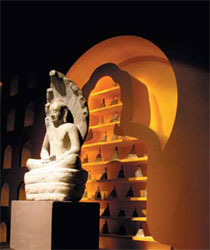A Thai view on ANM
Damn the begrudgers! - The Bangkok Post, Horizons
Less than a year old, the Angkor National Museum in Siem Reap has already come in for a lot of flack; we paid a visit recently to see what all the hullabaloo was about.
With Angkor Wat in its backyard (or is it the other way around?), the town of Siem Reap is a revolving door for tourists eager to gaze on the remnants of the majestic architecture of a once-powerful civilisation. The sheer size of this temple complex is, in itself, overwhelming. And while a stroll through the site is always an eye-popping experience, the surviving structures are, quite literally, shells of their former glorious selves. All the statuary and other sacred objects that escaped the attention of looters have long since been removed for safe-keeping. Most of the artefacts were transferred to the National Museum in Phnom Penh where lack of display space means that a lot of them are kept locked away in warehouses. Enter the Angkor National Museum, a $15 million project which is divided into eight themed zones and covers an area of 20,000m2; it is, remarkably, Siem Reap's first full-scale museum.
It was officially opened late last year but finishing touches are still being put to the so-called Cultural Mall, a building adjacent to the museum proper which features a host of gift shops, restaurants and even a spa - a one-stop centre for those in search of sustenance, souvenirs and retail therapy. The modern facilities in the museum include numerous interactive presentations; visitors are free to manipulate the controls of audio-visual displays which come with commentary in a choice of seven languages (English, Cambodian, French, Thai, Japanese, Chinese and Korean). The first of these presentations is encountered at the very start of your tour, in an 80-seat briefing hall where you are shown a brief video, a primer for everything you'll encounter during your visit. The first gallery you enter isn't even counted among the eight aforementioned zones, but it certainly doesn't pale in comparison; in fact it's one of the highlights of the whole place. A special exhibition aptly entitled "1,000 Buddha Images", for it features (you guessed it!) 1,000 Buddha statues ranging from the pre-Angkor (1st to 8th century AD) and Angkor (8th to 14th century) periods to the present day. The oldest dates from the 6th century. The juxtaposing of the different eras allows one to see the marked variations in style. The pre-Angkor images show strong Indian influences and are carved mostly from sandstone while those from the Angkor period utilise both sandstone and bronze. The post-Angkor Buddhas on display here are made from wood and various metals and exhibit many similarities to statues one might come across in a Thai wat. A striking feature of this hall is that all four walls have rows of niches housing hundreds of Buddha statuettes.
As one penetrates farther into the museum one progresses through Cambodia's illustrious past, touching on aspects of its history, culture, society, traditional costumes and spiritual beliefs. There are in excess 1,400 authentic artefacts in all, some, unfortunately, in poor condition. A focal point of interest is the Angkor Wat zone where one can pore over a fascinating, miniature scale model of the temple complex and watch a video explaining the methods used in its construction. Although the museum's government-appointed curator, Chann Charouen, is a Cambodian national, there has been much mumbling and grumbling of late about the folks behind this project. The Thai folks, that is. Yes, it may raise some eyebrows, but this museum is in fact the brainchild of a Thai company, a fact which has, understandably, drawn the ire of some Cambodians. (One can only hope that the ongoing stand-off over Preah Vihear/Khao Phra Viharn does not add fuel to the fire). Critics of the museum have accused the Thai investors of exploiting Cambodia's heritage to pocket a profit. And all sorts of wild rumours have been flying around. According to one (patently untrue) canard, it is mandatory for all visitors to walk through the official gift shop at the end of their tour. But then what new museum, aquarium or zoo in this day and age - Thai-run or otherwise - doesn't sport a souvenir shop with overpriced key chains and stuffed toys?
The Thai investors insist that their intentions are pure; that they set up this museum to showcase the rich cultural heritage of the Khmer Empire. They point out that, according to the terms of the agreement they signed with Phnom Penh officials, once their 30-year lease on the site and the exhibits (on loan from other museums in the country) expires, the Cambodian government will become the legal owner of the museum. Many still suspect the investors' motives, however, and this is hardly surprising given that the fingerprints of Thai entrepreneurs are to be found all over Siem Reap. No one seems to be making a fuss about these Thai-run businesses but then none of them are claiming to be a national museum, are they? All that aside, some areas of the museum could do with a bit of tweaking. Many of the artefacts on display still lack proper descriptions and much of the compound is under-lit, making it a bit hard on the eyes sometimes. Despite what its detractors say, the museum does offer an educational and aesthetically pleasing experience and - let's face it - it's still the only place in Siem Reap where you can see what once embellished the interiors of all those mesmerising ruins.



0 Comments:
Post a Comment
<< Home